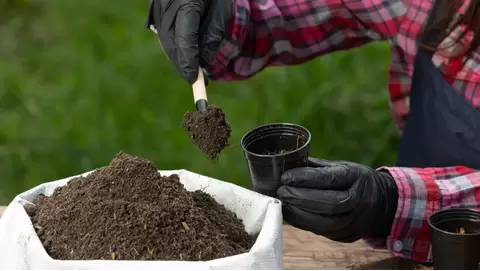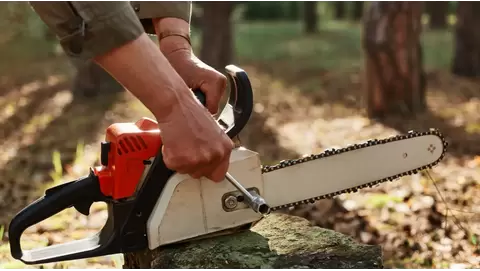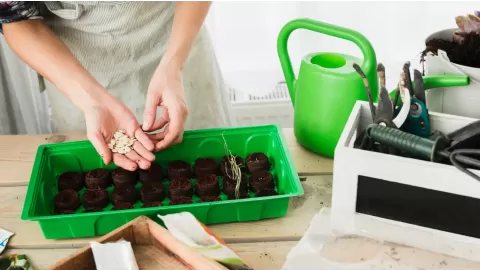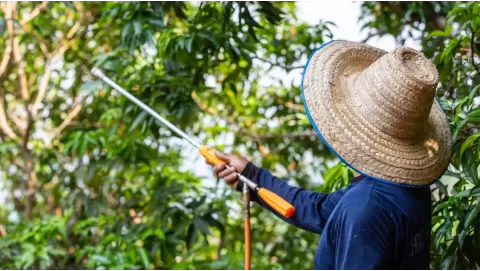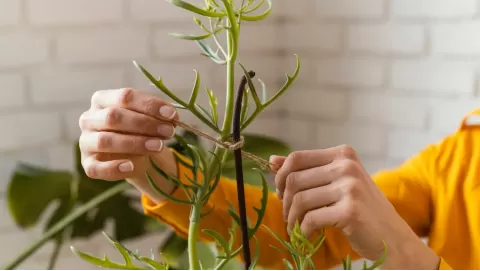
How to propagate a snake plant: Easy tips for multiplying your collection
The snake plant has sleek, sword-shaped leaves and upright leaves that look like a rising snake. It is an excellent selection for indoor gardening. Its botanical name is Sansevieria trifasciata. This dangerous plant has been a subject of numerous myths and facts, and one such myth is that the plant signifies good luck and protection in the house in certain cultures.
The snake plant is native to West Africa and is commonly found in Nigeria and the Congo. It was initially found by a German botanist by the name of Peter Simon around the year 1784. The snake plant is famously known as an air-purification powerhouse. They can also tolerate low-sun spaces and less watering, so busy plant lovers opt to adorn their homes with them.
This is one way that the culture of snake plants helps promote the growth of indoor gardening. The method is economic, but needs careful handling and approaches. A little bit of neglect can lead to root rot and the propagation method not working. There are a lot of new beginners who are having issues with the temperature, water supply, and overall growth environment. There are several ways that you can propagate Snake plants. That's the confusing part for new people – deciding which is the proper way, depending on their house environment and available building supplies.
Growcycle makes propagation of snake plants easy with top-quality gardening tools and rich nutrients. Their detailed handbooks and expert tips for various snake plant lineages – hybrids, species, and cultivars – help gardeners know what to plant and how to grow them. With all this available through Growcycle's resources, the average gardener can enjoy thriving growth and beautiful displays in any domestic setting.
Botany of Snake Plant
The leaves of the snake plant are sword-like and long. They're upright growers, forming variegated patterns of many colours, including green, white, and yellow. Their sculptural beauty enhances the indoor visual interest, and the slim, striped shapes promote a contemporary and edgy look for the house. The leaves are erect and may reach up to 47 inches long.
Snake plants have rhizomes and roots that are more like little twigs, helping to send their whispering threads throughout the soil safely. The underground rhizomes are used to store up nutrients from drought conditions, and the twig-fibrous roots are used to absorb nutrients from the soil. Such a unique and characteristic root system is also beneficial for transplantation. It gets into the spreading of its web, and quickly, new branches shoot out. The roots are sensitive and natural reservoirs of nutrients and moisture. Their adaptability keeps plants stable in extreme climates.
Growth Habits
The foliage of the Snake plant grows upright and compact. The young leaves arise from the center to form clumps of sepals. The unique growth habit of this plant will not need repotting, and it easily grows in a normal household setting. In the beginning, the leaves form in a rosette formation, allowing them to grow taller without hurting themselves.
Snake plants have slower growth in comparison to other house plants, although it can be moderate, provided they are in ideal conditions. Its nutrition is related to the care, essential growth items, and access to sunlight. Slow growth, though, is good news for busy plant enthusiasts, because the plant doesn’t require much care, and there will be no excess leaves to cut off.
The growth rate of snake plant is influenced by many factors, such as watering and fertilization, that work as accelerators to grow it quickly. Weather changes also influence the growth progress; in general, warm months are more favourable.
Environmental Adaptability
Snake plants are adaptable and, in this case, can acclimate to all environmental changes. They can also be fine in bit-shaded conditions, but indirect sunlight is important for strong development. The larger leaves of the plant store enough water to sustain its greenery in a long period of dormancy.
Keep the pots in bright parts of the house where some indirect sunlight can come in. It requires frequent watering and an average temperature to grow as quickly as possible.
Methods to Propagate a Snake Plant
There are a few ways snake plants can be propagated, but the most popular three are:
1. Propagation by Leaf Cuttings
Leaf cuttings are an effective way of propagating the snake plant. Even beginners can do it without failure, hard objects, and less effort to support the cut-off leaf. Here's a step-by-step propagation:
Tools Needed
- Clip the leaf cleanly with a sharp, clean knife or scissors.
- A new pot is needed to place the cut leaf and water it.
- Drained soil is required because wet soil can cause root rot, so plant the leaf roots in drained soil.
- Provide clean, fresh water in a clean container and replace as necessary.
Step-by-Step Guide
- Select a healthy leaf without any disease. The chosen leaf must be green, older, and wider to endure neglectful treatment. Trim the leaf in a single sweep for clean edges; a nicked leaf can develop an infection in water.
- Split the selected leaf if it is long into 4-6-inch pieces. Both sides should be nice and straight. Cut while the leaf edges are submerged in water near the base of the plant.
- Let the cut leaves dry for 1-2 days. This cooling of their edges will save the leaves from decaying as they stand in water in the act of forming roots.
- Stick these pieces into water for the root hormone and into the soil to grow. The leaves need to be 1-2 inches under the soil so the plant has the holding power.
- Water the roots in with as little water as possible. Do not overwater since it can easily rot the roots. Keep the temperature as indicated and check new plants for growth.
2. Propagation by Division
One type of snake plant propagation that is simple yet effective is through division, which is when you make new plants out of a single plant. This practice includes separating the plant into smaller fragments, each with at least some roots and leaves, and replanting them. Here's how to do it:
Tools Needed
- A sharp knife, scissors, or garden shears are necessary to cut the mother plant's roots into various sections. Sterilize the tools by rubbing with alcohol and apply them for cutting the safe side of the virus attack to baby plants.
- Take a healthy snake plant that has deeply established roots in the soil. Consider using the old plant because its complex anchors allow it to take maximum sections.
- Use clean pots with drainage holes so excess water can escape and air can pass through to help roots form.
- The cactus mix is the best with well-draining soil to ward off any attack by diseases and ensure the safety of the root system.
- Water is the key to eliminating the air pockets around post sections and plant roots.
Step-by-Step Guide
- Tapping on the sides of the pot, pull the plants out of the soil beneath and squeeze the leaves to release the gips of the roots. Remove it gently, do not harm the roots.
- Watch out for the rhizome of your mother plant and cut some sections with a sharp knife. Make sure the cutting has 2-3 small leaves or roots with a shoot and stem. It the roots of trees are well nourished, they soon strike into new soil without injury.
- Fill in with clean pots the emptied soil, cover all space but the watering space. Plant each division in a pot, dividing the roots properly, and at the right depth to grow.
- After planting, moisten the whole soil with an average amount of water. Place the prepared pots where they can get sufficient sunlight and air to grow.
- Continue to water with breaks, but don't flood them. Make sure the topsoil gets dry before you can water again. Observe their development and take appropriate actions to protect them against illness.
3. Propagation in Water
Propagating a snake plant in water is a simple and effective way to grow new plants. It requires rooting and cutting a leaf in water, then planting it in the ground. This propagation system is safe to utilise as the no-soil contact keeps the roots away from the bugs crawling up.
Gardeners with less space might choose it, since large pots are not required. Plants take in more nutrients from water, and growers can see the roots grow.
Tools Needed
- First of all, the mother plant needs to be healthy and strong, because it already has healthy roots.
- Select a glass jar or vase with which you can observe the roots' development. Wash it, dry it in the sun and get rid of all germ and pest threat.
- Water it with clean, room-temperature water for quicker growth.
- For safety, wear gloves and an apron. Sterilize the knife you plan to use to prevent the plant from getting a disease.
- Select green healthy leaves with strong and sharp edges to cut off. Mature leaves are able to weather the ups and downs of the environment and access more nutrients to support growth.
Step-by-Step Guide
- Take the healthier-stemmed plant, and snip off the leaves for repotting. Cut 2-3-inch sections and connect at least two or three leaves. Snip them away from that point of stem attachment, because from there, roots will grow into new stems.
- Snip the lower leaves with scissors and only use the upper ones for propagation. The bottom part can also rot when it is in water, and the roots in the jar.
- Fill a jar or vase of your choice with fresh water and place your bare section in it. Leave the upper leaves above water; wet leaves can rot the plant before growth starts.
- Observe the sprouts; they will take two to three weeks, depending on light exposure and care. Replace the water in one week and when 1-2 roots lengths show, transplant them in the soil.
- Move pots of soil with drainage into bright, airy areas. And then, take the roots up from the water and transplant them into the soil, covering all the roots with soil in pots. Gradually water these recent flowers to help them grow.
Tips for Successful Propagation
To achieve the best results from the space to be occupied, growers would need to work out the preferred environment and know as much as possible about plant anatomy. It will be good to know the plant’s botany and the chemistry of the minerals it requires. Some of the key tips gardeners should follow are:
Choosing the Right Time
Extremes in temperature should be avoided for propagation since there is a greater chance of newly developing roots rotting. So select the right time for planting the snake plant at the start of summer or the months of spring.
Proper Light and Temperature
Keep warm, give strong light at a mild temperature. Snake plant leaves can go yellow, or roots rot in overheated locations or where the direct sun is shining. In the corners of that house, set the drainage pots where indirect sunlight can pass.
If the area does not get enough light, supplement sunlight with an artificial grow light. Bedroom temperature should be kept at a constant of 65-78°f as fluctuations can disturb the growth speed. You can use the Air Pot Container Propagation Cell available at Growcycle for fast propagation in a reliable environment.
Avoid Using Dirty Water
Do not use sandy water for growing; keep an average proportion of it. Saturated water can cause the roots to rot. Cut with clean implements and not if the tools are dusty because they induce phytogen attacks. Let the roots grow out entirely before transplanting to the soil. When planting, roots fail to draw nutrients from the soil while they develop.
Advanced Propagation Techniques
Now, scientists in botanical labs and plant enthusiasts are applying a variety of high-tech tricks for highly orchestrated plant growth. They are looking to save time, increase plant growth, and not spend too many resources — they also want to minimize the chances of ruining the environment, which typically happens.
1. Using Root Hormones
Root hormones are very popular in advanced propagation. The active principle of this chemical is the same thing that auxin does in plant development. Root hormones help your roots grow quickly and healthily. These applications are made to stop the rotting of the roots and secure the otherwise normal development.
With root hormones, the failure rate is nominal. The root hormones also serve to stabilize new planting roots and improve the absorption of nutrients in the soil. Thus, their anchorage to soil is more robust, which contributes to the rapid growth of snake plants while ensuring deep rooting.
Types of root hormones
Liquid: Concentrated ingredients are simple to apply to fragile roots, and the chance of over-application is relatively low as a liquid.
Powder: This dry hormone is designed for expert gardeners since it can be messy and create a lot of dust, which may deter novices.
Gel: The sticky hormones are easy to apply or odd stems and angles, and they are simple to handle. It is easy for the user to use since he or she can just put the coating on the roots of the snake plant.
Application methods
- Moisten the roots of the cutting and dust them with the root hormone powder. Dust off the excess powder before inserting it into the soil. The second method for powder form is to mix it in the propagation soil and plant the cutting roots in this treated soil.
- If the rooting hormone is liquid, the grower should dip the bottom of the cutting into the hormone for a couple of seconds, and then insert it into the hole. Otherwise, they need to mix the liquid in the water of the propagation medium and then submerge the cuttings in it.
- Then spread the hormone gel evenly over the roots and then plant it into the soil.
2. Propagation in Different Mediums
Propagation gives you more than one option to select for growing plants. Every medium has its advantages and disadvantages, and choosing the one that will work best is essential. Here’s a good comparison of water and soil propagation to help you make your decision:
- Soil vs. Water Propagation
There are abundant natural nutrients in the soil to grow new roots. Its rate of stability is also higher than water’s, which promotes the snake plant to open up its roots. The likelihood of pests getting to the root and rotting is considerably greater in a soil-based medium, though. It’s very hard to water in the soil, it’s very hard to plant in the soil because the soil can be over-wet or extra-dry, and then baby roots will be injured.
Contrarily, the low-cost water medium can be used for propagation at a lower scale. The transparent medium makes it easy for growers to observe the growth progress for the perfect time to plant out in soil. Water alone can supply the necessary nutrients long-term to develop the roots into an adult plant. Since water is not firm, the wet root can become unstable or limp in the medium.
- Using Perlite or Vermiculite
Perlite allows for adequate soil drainage and prevents root rots from getting oversaturated. It also enhances the aeration in the drainage hole. If mixed with the soil, it will offer better results, and you might want to aim for a 1 part perlite and 1 part soil ratio in the beginning. Vermiculite can enhance nutrient uptake of the new roots, and helps in aerating potholes. Vermiculite comes in handy with snake plants that require more water compared to perlite.
Besides these, growers can also use a propagation kit with a wood base, which is easily fixable in any home decor and gives beauty to the home, along with a plant propagation facility.
How to Care for Newly Propagated Plants?
Here are a few tips to help you take care of your new snake plant.
Watering Schedule
The newly rooted plants must be watered daily, or on alternate days, and we have to make the soil wet. Stick with that regimen for one week, then reduce to resting twice to three times on a weekly basis. Underwater plants have crispy and dry foliage. Yellowing leaves on plants is often a symptom of overwatering. Their development is soft as well; check the status of the leaf and only water when needed.
Light Requirements
The first days of roots need dim to middle light, as bright light can affect their growth. Put cuttings in bright spots, but not in direct sun. Instead, work with angles that can relay indirect sunlight beams. Plus, a propagation mat delivers a high survival rate and much quicker rooting due to the maintenance of a target bottom heat.
Fertilizer
When you've just propagated your snake plant, you'll want to be careful when fertilizing. Give the plants a few weeks to settle into their new soil before fertilizing. Once the plants are established, feed them with a balanced, water-soluble fertilizer, such as a 10-10-10 or 20-20-20 formula. Be sure to lower the fertilizer solution to half or below half strength. Snake plants are light feeders, and a dilute solution prevents over-fertilization.
Use the diluted fertilizer every 4-6 weeks throughout the growing season (spring and summer). It’s ideal to hold off on fertilizing in the fall and winter when the plants are growing more slowly. Fertilize the plant, making sure to water before and after fertilizing. This will facilitate a wet, but not soggy, soil, leading to an even pattern of the nutrients and not causing root burn. Don’t let the fertilizer touch their leaves; it may burn.
FAQs
How long does it take for snake plant cuttings to root?
It depends on proper care and environmental conditions, but snake plants can take one to four months to get proper roots. This period can increase and decrease according to the plant variation and care pattern.
Can I propagate a snake plant from a single leaf?
Yes, you can multiply one leaf into several plants. Cut the leaf into pieces, then transplant it into the soil or water to propagate and grow roots.
What should I do if the cuttings are not rooting?
There are several explanations for why the cuttings aren’t rooting. Take care of the cuttings. Keep them at the right temperature and do not overwater. Dip the root in a hormone powder or gel; this will help speed up the rooting system.
The Bottom Line
Propagating a snake plant can be a rewarding and cost-effective method of expanding an indoor gardening collection. Every distribution discussed here has its own advantages and disadvantages. During spring season and summer, share the snake plants in good light, temperature, clean water and tools to successfully propagate.
Remember to explore Growcycle, which is equipped with all the necessary advanced tools for snake plant propagation. You should select the best equipment to enhance the growth of the plants. It is easier and more enjoyable to propagate with the tools of Growcycle, and your snake plant life grows beautifully.
Disclaimer: This material is for informational purposes only and should not be relied on for legal, medical, financial, or other professional advice.


